Abstract
The extent of immunological similarity between tetanus toxin and botulinum toxins A, B, C1, and E was studied by using 10 antibodies produced against synthetic peptides representing different sequences of tetanus toxin, mouse antitetanus serum, and human Tetanus Immune Globulin. Antibodies produced against the synthetic peptides recognized tetanus toxin in an enzyme-linked immunosorbent assay and on Western blots (immunoblots) but did not appear to recognize the native protein. One of the antitetanus peptide antibodies, which was produced against a peptide from the amino terminal, cross-reacted with three of the four botulinum toxins on immunoblots. This antibody, 1, reacted strongly with botulinum toxins B and C1 and weakly with E but did not recognize type A toxin. None of the other peptide antibodies cross-reacted with the botulinum toxins. Mouse antitetanus serum and human Tetanus Immune Globulin did not recognize any of the botulinum toxins on immunoblots. The amino-terminal region of the light chain of tetanus toxin and botulinum toxin types A, B, C1, and E are known to have sequence homology. Our data demonstrate that for tetanus toxin and botulinum toxin types B, C1, and E this region also has immunological homology. Type A, which has the least amount of homology with tetanus toxin in this region, does not share this immunological homology. These data also suggest that although the native structures of tetanus and botulinum toxins have relatively few common immunological determinants, the two toxins may contain short stretches of identical or very similar amino acid sequences.
Full text
PDF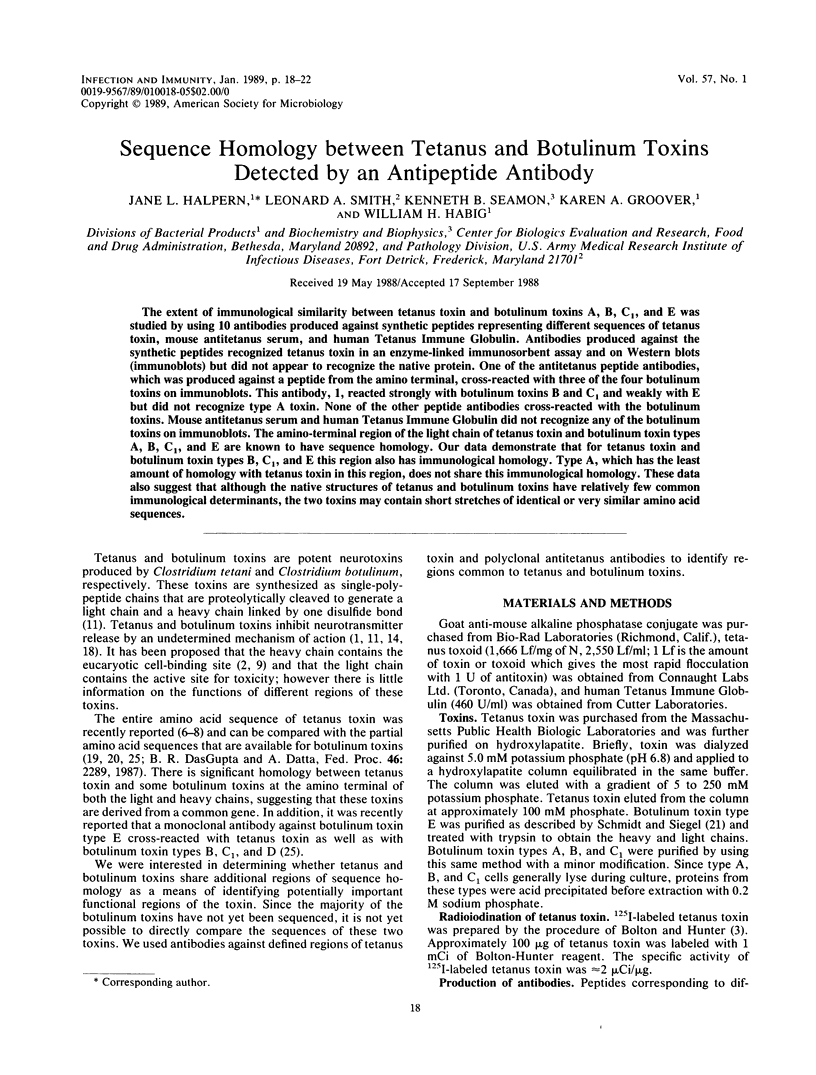
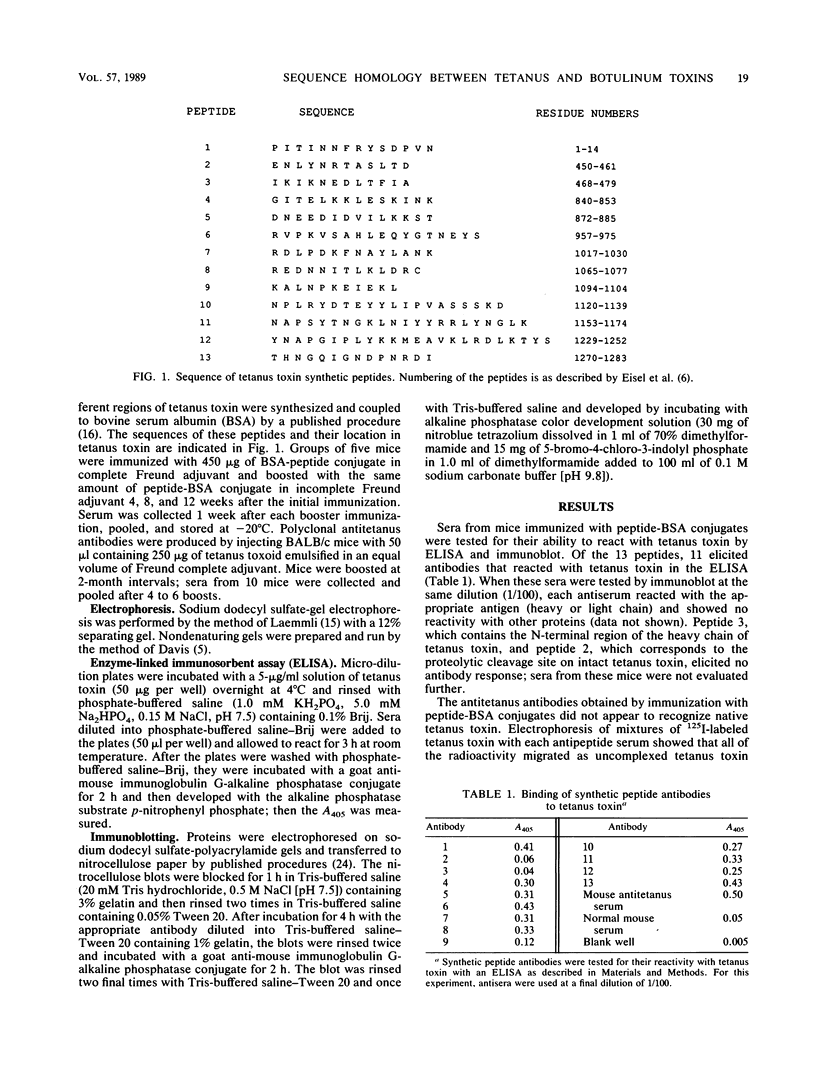
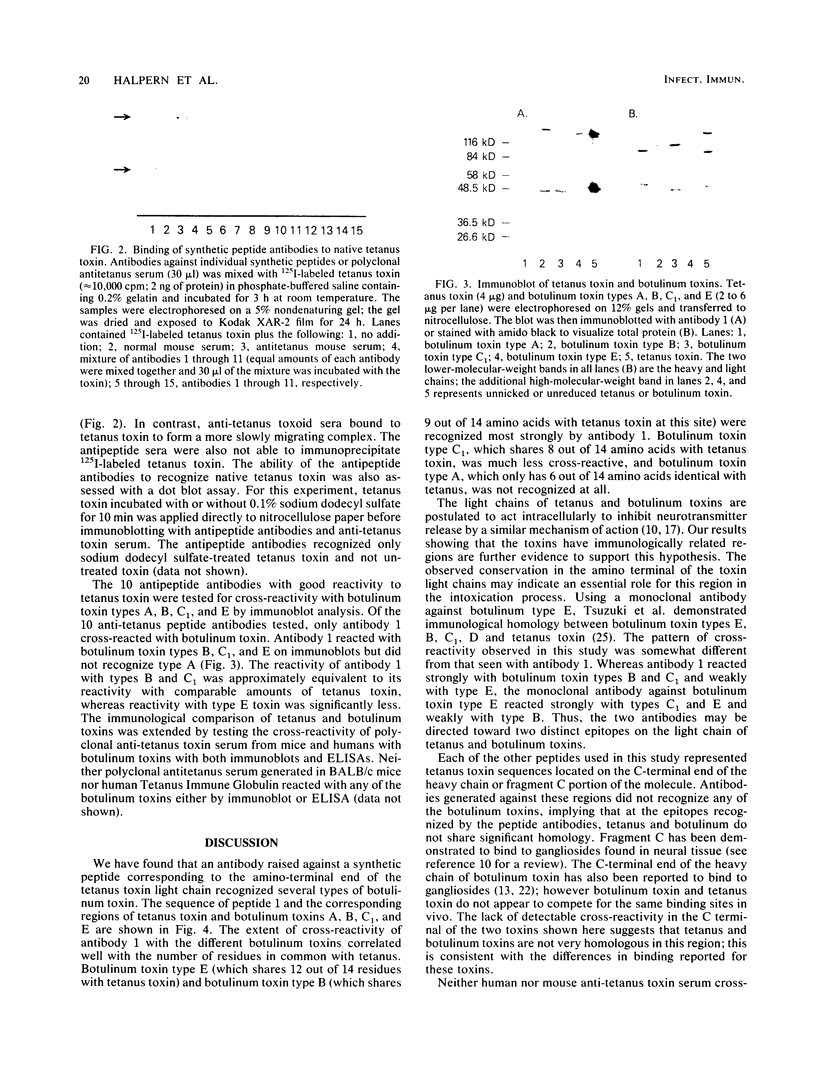
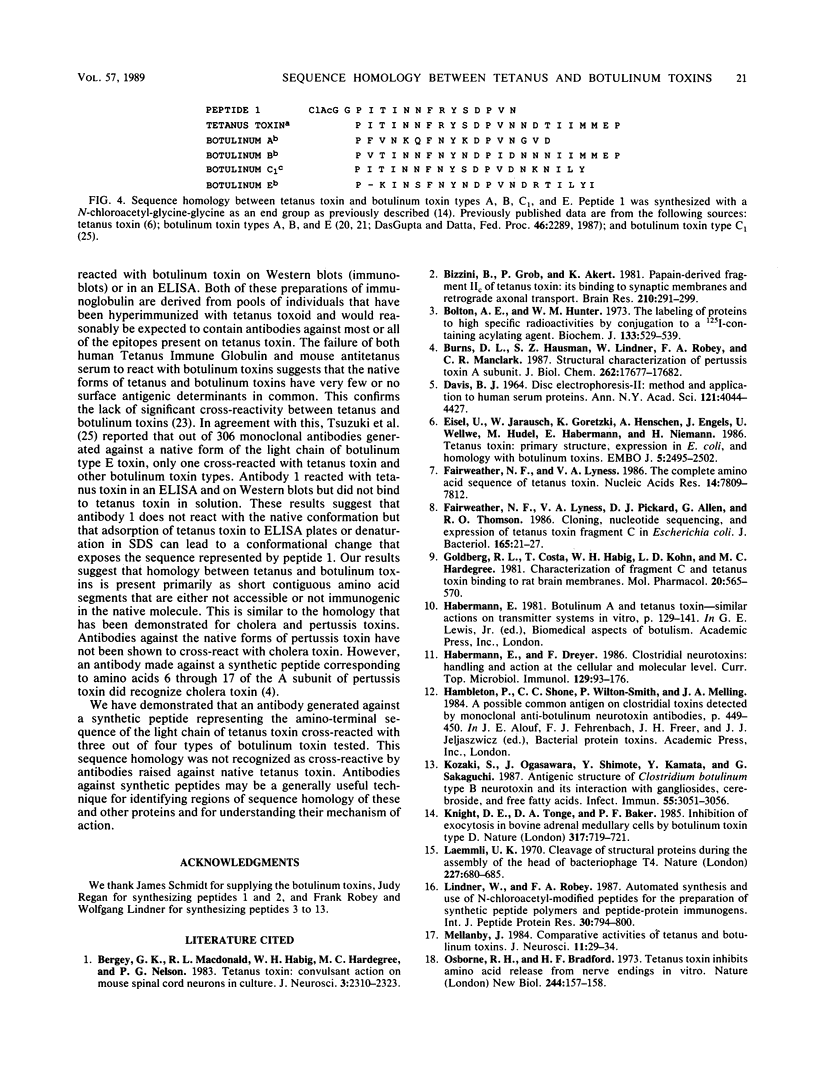
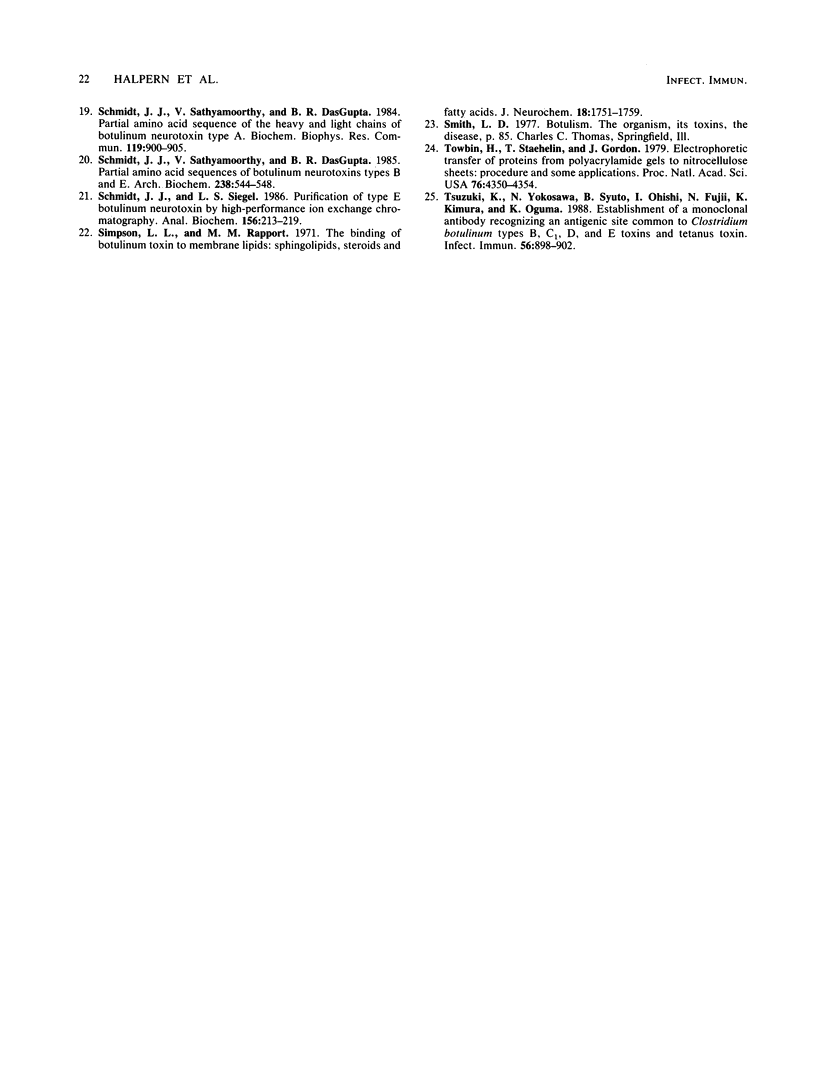
Images in this article
Selected References
These references are in PubMed. This may not be the complete list of references from this article.
- Bergey G. K., MacDonald R. L., Habig W. H., Hardegree M. C., Nelson P. G. Tetanus toxin: convulsant action on mouse spinal cord neurons in culture. J Neurosci. 1983 Nov;3(11):2310–2323. doi: 10.1523/JNEUROSCI.03-11-02310.1983. [DOI] [PMC free article] [PubMed] [Google Scholar]
- Bizzini B., Grob P., Akert K. Papain-derived fragment IIc of tetanus toxin: its binding to isolated synaptic membranes and retrograde axonal transport. Brain Res. 1981 Apr 6;210(1-2):291–299. doi: 10.1016/0006-8993(81)90902-1. [DOI] [PubMed] [Google Scholar]
- Bolton A. E., Hunter W. M. The labelling of proteins to high specific radioactivities by conjugation to a 125I-containing acylating agent. Biochem J. 1973 Jul;133(3):529–539. doi: 10.1042/bj1330529. [DOI] [PMC free article] [PubMed] [Google Scholar]
- Burns D. L., Hausman S. Z., Lindner W., Robey F. A., Manclark C. R. Structural characterization of pertussis toxin A subunit. J Biol Chem. 1987 Dec 25;262(36):17677–17682. [PubMed] [Google Scholar]
- Eisel U., Jarausch W., Goretzki K., Henschen A., Engels J., Weller U., Hudel M., Habermann E., Niemann H. Tetanus toxin: primary structure, expression in E. coli, and homology with botulinum toxins. EMBO J. 1986 Oct;5(10):2495–2502. doi: 10.1002/j.1460-2075.1986.tb04527.x. [DOI] [PMC free article] [PubMed] [Google Scholar]
- Fairweather N. F., Lyness V. A., Pickard D. J., Allen G., Thomson R. O. Cloning, nucleotide sequencing, and expression of tetanus toxin fragment C in Escherichia coli. J Bacteriol. 1986 Jan;165(1):21–27. doi: 10.1128/jb.165.1.21-27.1986. [DOI] [PMC free article] [PubMed] [Google Scholar]
- Fairweather N. F., Lyness V. A. The complete nucleotide sequence of tetanus toxin. Nucleic Acids Res. 1986 Oct 10;14(19):7809–7812. doi: 10.1093/nar/14.19.7809. [DOI] [PMC free article] [PubMed] [Google Scholar]
- Goldberg R. L., Costa T., Habig W. H., Kohn L. D., Hardegree M. C. Characterization of fragment C and tetanus toxin binding to rat brain membranes. Mol Pharmacol. 1981 Nov;20(3):565–570. [PubMed] [Google Scholar]
- Habermann E., Dreyer F. Clostridial neurotoxins: handling and action at the cellular and molecular level. Curr Top Microbiol Immunol. 1986;129:93–179. doi: 10.1007/978-3-642-71399-6_2. [DOI] [PubMed] [Google Scholar]
- Knight D. E., Tonge D. A., Baker P. F. Inhibition of exocytosis in bovine adrenal medullary cells by botulinum toxin type D. Nature. 1985 Oct 24;317(6039):719–721. doi: 10.1038/317719a0. [DOI] [PubMed] [Google Scholar]
- Kozaki S., Ogasawara J., Shimote Y., Kamata Y., Sakaguchi G. Antigenic structure of Clostridium botulinum type B neurotoxin and its interaction with gangliosides, cerebroside, and free fatty acids. Infect Immun. 1987 Dec;55(12):3051–3056. doi: 10.1128/iai.55.12.3051-3056.1987. [DOI] [PMC free article] [PubMed] [Google Scholar]
- Laemmli U. K. Cleavage of structural proteins during the assembly of the head of bacteriophage T4. Nature. 1970 Aug 15;227(5259):680–685. doi: 10.1038/227680a0. [DOI] [PubMed] [Google Scholar]
- Lindner W., Robey F. A. Automated synthesis and use of N-chloroacetyl-modified peptides for the preparation of synthetic peptide polymers and peptide-protein immunogens. Int J Pept Protein Res. 1987 Dec;30(6):794–800. doi: 10.1111/j.1399-3011.1987.tb03388.x. [DOI] [PubMed] [Google Scholar]
- Mellanby J. Comparative activities of tetanus and botulinum toxins. Neuroscience. 1984 Jan;11(1):29–34. doi: 10.1016/0306-4522(84)90213-6. [DOI] [PubMed] [Google Scholar]
- Osborne R. H., Bradford H. F. Tetanus toxin inhibits amino acid release from nerve endings in vitro. Nat New Biol. 1973 Aug 1;244(135):157–158. doi: 10.1038/newbio244157a0. [DOI] [PubMed] [Google Scholar]
- Schmidt J. J., Sathyamoorthy V., DasGupta B. R. Partial amino acid sequence of the heavy and light chains of botulinum neurotoxin type A. Biochem Biophys Res Commun. 1984 Mar 30;119(3):900–904. doi: 10.1016/0006-291x(84)90858-1. [DOI] [PubMed] [Google Scholar]
- Schmidt J. J., Sathyamoorthy V., DasGupta B. R. Partial amino acid sequences of botulinum neurotoxins types B and E. Arch Biochem Biophys. 1985 May 1;238(2):544–548. doi: 10.1016/0003-9861(85)90198-5. [DOI] [PubMed] [Google Scholar]
- Schmidt J. J., Siegel L. S. Purification of type E botulinum neurotoxin by high-performance ion exchange chromatography. Anal Biochem. 1986 Jul;156(1):213–219. doi: 10.1016/0003-2697(86)90175-2. [DOI] [PubMed] [Google Scholar]
- Simpson L. L., Rapport M. M. The binding of botulinum toxin to membrane lipids: sphingolipids, steroids and fatty acids. J Neurochem. 1971 Sep;18(9):1751–1759. doi: 10.1111/j.1471-4159.1971.tb03750.x. [DOI] [PubMed] [Google Scholar]
- Towbin H., Staehelin T., Gordon J. Electrophoretic transfer of proteins from polyacrylamide gels to nitrocellulose sheets: procedure and some applications. Proc Natl Acad Sci U S A. 1979 Sep;76(9):4350–4354. doi: 10.1073/pnas.76.9.4350. [DOI] [PMC free article] [PubMed] [Google Scholar]
- Tsuzuki K., Yokosawa N., Syuto B., Ohishi I., Fujii N., Kimura K., Oguma K. Establishment of a monoclonal antibody recognizing an antigenic site common to Clostridium botulinum type B, C1, D, and E toxins and tetanus toxin. Infect Immun. 1988 Apr;56(4):898–902. doi: 10.1128/iai.56.4.898-902.1988. [DOI] [PMC free article] [PubMed] [Google Scholar]




